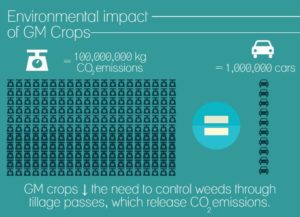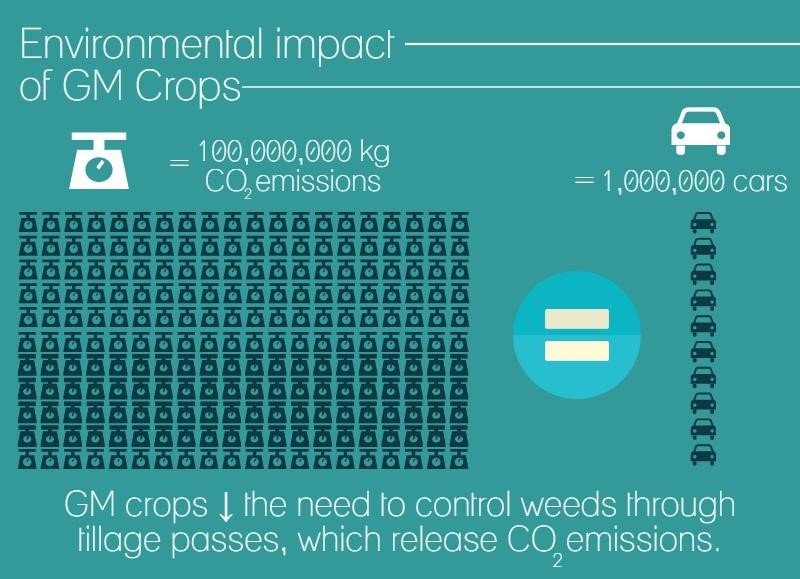Feeding an additional 2-5 billion people over the coming 30 years is going to challenge every single aspect of agriculture and food production. While some early advocates of biotechnology and GM crops enthusiastically proclaimed that GM crops could feed the world, the reality 20 years later is that they are an important technology that contributes to improving food security.
The biotech industry, like others, assesses their own performances from one year to the next and recent reports have shown biotech continues to increase food security. To evaluate this, the biotech industry contracts consulting group, PG Economics, to report on the global impacts of biotechnology. Previous results have been peer reviewed and published in the journal GM Crops and Foods. PG Economic recently released their report on 2014 GM crop data.
 Among the findings, the environmental improvements reported by GM crops have been significant. In 2014, GM crops were the most effective way to control weeds. This means fewer tillage passes were made over fields, therefore, less CO2 was emitted. In 2014, CO2 emissions were reduced by 22 billion kilograms, equivalent to removing 10 million cars from the road for one year.
Among the findings, the environmental improvements reported by GM crops have been significant. In 2014, GM crops were the most effective way to control weeds. This means fewer tillage passes were made over fields, therefore, less CO2 was emitted. In 2014, CO2 emissions were reduced by 22 billion kilograms, equivalent to removing 10 million cars from the road for one year.
GM crops also require fewer pesticide applications, particularly with GM cotton and corn. For GM cotton, pesticide applications have been reduced by as many as 15 applications per year compared to non-GM varieties. The cumulative impact has been a reduction of 580 kilograms of pesticide application, equal to the total amount of pesticides that China would apply in one year. The environmental impact of removing these chemical applications has resulted in an improvement of 18%.
GM crops provide better weed and insect control, meaning farmers lose less yield to both. There are yield increases due to the improved plant genetics of GM crops, but the majority of economic benefits come from improving pest and weed control. In 2014, the global economic benefit was over $17 billion. The cumulative benefit has now passed $150 billion, which has been evenly split between farmers in developing and developed countries.
Higher yields have allowed farmers all over the world to produce more food with the same amount of land. If the world no longer had the benefit of GM crops, more land would be required to produce the current levels of crops. For example, the world would need an additional 16 million acres of soybeans and nearly 20 million additional acres of corn. The amount of extra land required would be equal to one-third of all the farmable land in Brazil. In terms of simple economics, higher yields mean greater supplies, which contribute to keeping food price increases lower than they might otherwise be.
Many often wonder whether there are benefits for farmers, as the price of GM crop seeds are higher than the seed price of non-GM alternatives. The report finds that for every dollar farmers invested in buying GM seed in developed countries, $3.14 is earned in production and harvest benefits. The level of benefit rises for farmers in developing countries as for every dollar they invest, they’re provided with $4.42 of benefits.
While it’s true that GM crops can’t feed the world on their own, they positively contribute to feeding the world with an increasing population.
While the articles from the current report are undergoing peer review the economic and environmental publications based on the 2013 report are available.



Hmm. The National Academies of Science report says there is no evidence that GM crops have increase yields overall and that HR resistant crops have not sustained a decrease in herbicide applications.
I led a research team that compared GM canola production in 2005 with conventional canola production in 1995. We quantified that GM canola resulted in an annual reduction of 1.3 million kilograms of chemical active ingredient applied to canola fields in Western Canada. In 2005, the environmental impact of GM canola was 53% lower than the environmental impact of conventional canola. We are conducting this survey again this year to find out what the benefits are after 20 years of GM crop production. Our peer reviewed research certainly supports the conclusions that Brookes and Barfoot provide.
Pingback: Plowing Into 2017: The Top 50 Farming and Agriculture Blogs - Lawnstarter
Thank for sharing, the article is very interesting. I really liked your view about farming. Really looking forward to read more.